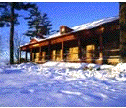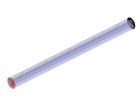











Dr. Goodarz Ahmadi
Director, TMFL
Clarkson U.
Potsdam, NY 13699
315-268-2322
ahmadi@clarkson.edu
|
Supersonic Impactors and Aerodynamic Lenses Supersonic Impactors Low pressure impactors make use of sonic jets for the separation and collection of submicron particles. When a supersonic stream impinges on the solid wall it produces a detached shock in front of the surface. Therefore the gas flow decelerates to subsonic velocities, while passing through this shock, and then radially expands again to supersonic velocities along the wall. Because of this complicated flow structures, the theoretical studies on the supersonic particle impaction are rather scarce despite their useful application. In this project, numerical simulations are performed to capture the flow field and the particle trajectory at this field. For these purposes, compressible Navier-Stokes equations are employed to compute the supersonic flow and Lagrangian description is used for particle tracking.
Mach number contours in a supersonic/hypersonic Impactor. Aerodynamic Lenses Aerodynamic lenses are used to generate focused particle beams. These lenses are formed by properly designed combinations of axisymmetric contractions and expansions. Particles in a critical size range passing through the contractions are drifted toward to the axis and form a narrow beam. The larger particles are removed from the stream by the inertial impaction, and smaller particles follow the flow streamlines. The diameter of the focused particle beam can be controlled with the use of a number of lenses with different contraction diameters. In this project, airflow and particle motions in a multistage aerodynamic lens with the end nozzle are studied. In addition to analysis of the flow field and particle motions inside the lens and the outlet nozzle, the flow down stream of the nozzle is also studied.
Sample 10 nm particle trajectories in the aerodynamic lens system. |

